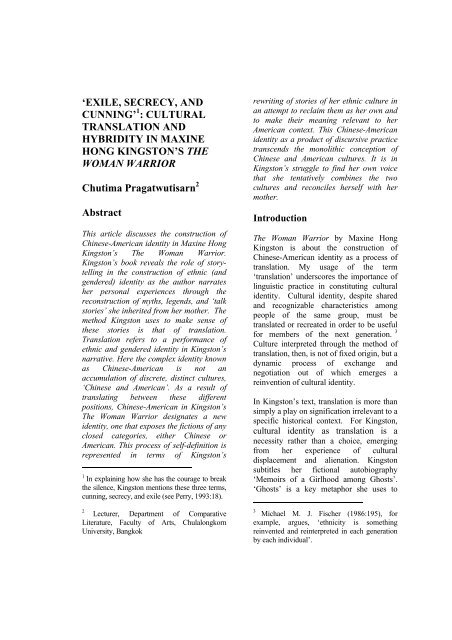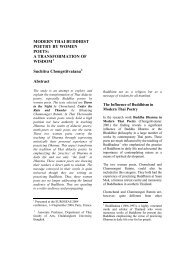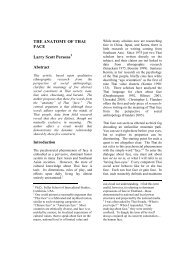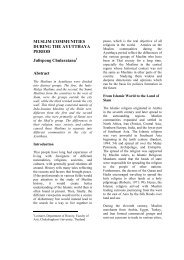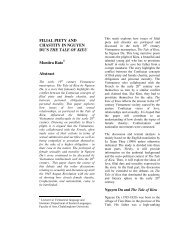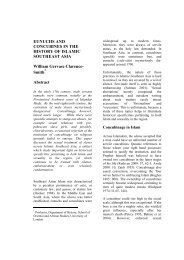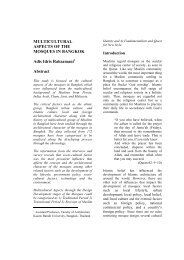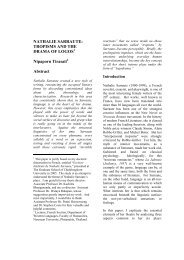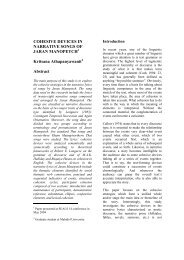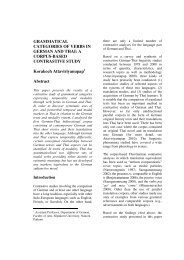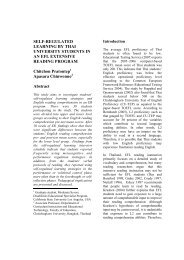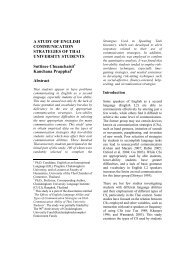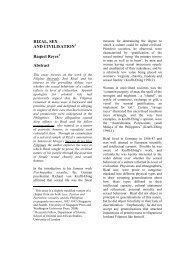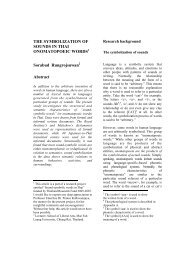maxine hong kingston.pdf - Manusya :: Journal of Humanities
maxine hong kingston.pdf - Manusya :: Journal of Humanities
maxine hong kingston.pdf - Manusya :: Journal of Humanities
Create successful ePaper yourself
Turn your PDF publications into a flip-book with our unique Google optimized e-Paper software.
‘EXILE, SECRECY, AND<br />
CUNNING’ 1 : CULTURAL<br />
TRANSLATION AND<br />
HYBRIDITY IN MAXINE<br />
HONG KINGSTON’S THE<br />
WOMAN WARRIOR<br />
Chutima Pragatwutisarn 2<br />
Abstract<br />
This article discusses the construction <strong>of</strong><br />
Chinese-American identity in Maxine Hong<br />
Kingston’s The Woman Warrior.<br />
Kingston’s book reveals the role <strong>of</strong> storytelling<br />
in the construction <strong>of</strong> ethnic (and<br />
gendered) identity as the author narrates<br />
her personal experiences through the<br />
reconstruction <strong>of</strong> myths, legends, and ‘talk<br />
stories’ she inherited from her mother. The<br />
method Kingston uses to make sense <strong>of</strong><br />
these stories is that <strong>of</strong> translation.<br />
Translation refers to a performance <strong>of</strong><br />
ethnic and gendered identity in Kingston’s<br />
narrative. Here the complex identity known<br />
as Chinese-American is not an<br />
accumulation <strong>of</strong> discrete, distinct cultures,<br />
‘Chinese and American’. As a result <strong>of</strong><br />
translating between these different<br />
positions, Chinese-American in Kingston’s<br />
The Woman Warrior designates a new<br />
identity, one that exposes the fictions <strong>of</strong> any<br />
closed categories, either Chinese or<br />
American. This process <strong>of</strong> self-definition is<br />
represented in terms <strong>of</strong> Kingston’s<br />
1 In explaining how she has the courage to break<br />
the silence, Kingston mentions these three terms,<br />
cunning, secrecy, and exile (see Perry, 1993:18).<br />
2<br />
Lecturer, Department <strong>of</strong> Comparative<br />
Literature, Faculty <strong>of</strong> Arts, Chulalongkorn<br />
University, Bangkok<br />
rewriting <strong>of</strong> stories <strong>of</strong> her ethnic culture in<br />
an attempt to reclaim them as her own and<br />
to make their meaning relevant to her<br />
American context. This Chinese-American<br />
identity as a product <strong>of</strong> discursive practice<br />
transcends the monolithic conception <strong>of</strong><br />
Chinese and American cultures. It is in<br />
Kingston’s struggle to find her own voice<br />
that she tentatively combines the two<br />
cultures and reconciles herself with her<br />
mother.<br />
Introduction<br />
The Woman Warrior by Maxine Hong<br />
Kingston is about the construction <strong>of</strong><br />
Chinese-American identity as a process <strong>of</strong><br />
translation. My usage <strong>of</strong> the term<br />
‘translation’ underscores the importance <strong>of</strong><br />
linguistic practice in constituting cultural<br />
identity. Cultural identity, despite shared<br />
and recognizable characteristics among<br />
people <strong>of</strong> the same group, must be<br />
translated or recreated in order to be useful<br />
for members <strong>of</strong> the next generation. 3<br />
Culture interpreted through the method <strong>of</strong><br />
translation, then, is not <strong>of</strong> fixed origin, but a<br />
dynamic process <strong>of</strong> exchange and<br />
negotiation out <strong>of</strong> which emerges a<br />
reinvention <strong>of</strong> cultural identity.<br />
In Kingston’s text, translation is more than<br />
simply a play on signification irrelevant to a<br />
specific historical context. For Kingston,<br />
cultural identity as translation is a<br />
necessity rather than a choice, emerging<br />
from her experience <strong>of</strong> cultural<br />
displacement and alienation. Kingston<br />
subtitles her fictional autobiography<br />
‘Memoirs <strong>of</strong> a Girlhood among Ghosts’.<br />
‘Ghosts’ is a key metaphor she uses to<br />
3 Michael M. J. Fischer (1986:195), for<br />
example, argues, ‘ethnicity is something<br />
reinvented and reinterpreted in each generation<br />
by each individual’.
describe the experience <strong>of</strong> cultural<br />
alienation. The term is applied to alien,<br />
insubstantial, invisible beings, both humans<br />
and spirits. The landscape <strong>of</strong> Kingston’s<br />
girlhood is haunted by ‘ghosts’ — stories <strong>of</strong><br />
women who live in exile not only<br />
physically but culturally and<br />
psychologically. Of these women, the<br />
successful ones are those who know how to<br />
‘translate’ themselves to overcome their<br />
ghostly existence. Translation understood<br />
in the context <strong>of</strong> displacement is a method<br />
whereby a displaced person can ‘unghost’<br />
herself by transforming absence and<br />
invisibility into meaning and identity.<br />
I<br />
Translation implies that an ‘interruption’<br />
has occurred, that something has been — to<br />
borrow Homi Bhabha’s term — ‘blasted<br />
out <strong>of</strong> a homogeneous continuum’,<br />
(1992:48) forcing a production <strong>of</strong> meaning<br />
across, instead <strong>of</strong> within, cultural<br />
boundaries. Yet the fact that language is a<br />
translation from one to another also<br />
suggests the relationship between linguistic<br />
signs and the continuation <strong>of</strong> meaning.<br />
Disjunction and association are two integral<br />
elements <strong>of</strong> translation, rendering it a<br />
complex and ambiguous process.<br />
Gilles Deleuze and Felix Guattari use the<br />
term ‘deterritorialization’ to describe the<br />
crisis <strong>of</strong> totality as a postmodern<br />
phenomenon that takes place in the realm<br />
<strong>of</strong> language and literature. Caren Kaplan<br />
(1987:188) notes that their usage <strong>of</strong> the<br />
term describes ‘the effects <strong>of</strong> radical<br />
distanciation between signifier and<br />
signified. Meaning and utterances become<br />
estranged’. A sense <strong>of</strong> security once made<br />
possible by the unity between signifier and<br />
signified now gives way to a state <strong>of</strong><br />
confusion, an effect <strong>of</strong> cultural alienation.<br />
Translation then becomes necessary when<br />
Cultural Translation and Hybridity in The Woman Warrior<br />
25<br />
the production <strong>of</strong> meaning within a safe<br />
space called home is no longer possible. As<br />
Deleuze and Guattari (qtd. in Kaplan,<br />
1987:188) ask, ‘How many people live<br />
today in a language that is not their own?’,<br />
reminding us <strong>of</strong> linguistic<br />
deterritorialization in this age <strong>of</strong><br />
displacement, exile, and mass migration.<br />
However, translation as recuperation <strong>of</strong><br />
meaning is not simply a process <strong>of</strong><br />
returning to our origin. Deterritorialization,<br />
even as it produces alienation, also gives<br />
freedom for imagination to express ‘another<br />
potential community, to force the means for<br />
another consciousness and another<br />
sensibility’ (see Kaplan, 1987:190). Living<br />
in translation then, involves both perils and<br />
possibilities that make a translator feel like<br />
a secret agent in a foreign territory.<br />
My focus on a postcolonial approach to<br />
translation is a response to a call made by<br />
Bhabha (1992:48) for ‘reinterpreting and<br />
rewriting the forms and effects <strong>of</strong> ‘older’<br />
colonial consciousness from the later<br />
experience <strong>of</strong> cultural displacement that<br />
marks the more recent, postwar histories <strong>of</strong><br />
the Western metropolis’. Translation in my<br />
discussion is more than just an exercise <strong>of</strong><br />
linguistic skills. It is a way <strong>of</strong> living for<br />
minority people whose experience <strong>of</strong><br />
cultural alienation makes it necessary for<br />
them to translate themselves from the<br />
outside in. 4 A massive migration <strong>of</strong><br />
nonwhite people to a Western metropolis<br />
may lead us to believe that the binary<br />
between us/them, underwritten by the<br />
notion that permanently ties a culture to a<br />
4 See Paul Jay (1997:405-31) and his<br />
application <strong>of</strong> translation methods to the<br />
reading <strong>of</strong> Carlos Fuentes’s ‘The Two Shores’.<br />
Though different in context, Jay’s approach to<br />
translation is similar in several aspects to my<br />
reading <strong>of</strong> Kingston’s The Woman Warrior.
MANUSYA: <strong>Journal</strong> <strong>of</strong> <strong>Humanities</strong> (Special Issue No.10 2005)<br />
fixed terrain, will soon be wiped away. Yet<br />
the experience <strong>of</strong> many immigrants and<br />
their descendants who literally are there and<br />
still find themselves as alien and exotic as<br />
ghosts belies such an optimistic view. The<br />
distinction between the domestic and the<br />
exotic is an example <strong>of</strong> how the West is<br />
still unable to accept that their culture is<br />
never pure and unified but that is<br />
heterogeneously constituted from the very<br />
beginning.<br />
An individual may deploy a strategy <strong>of</strong><br />
translation to challenge the claim <strong>of</strong> a<br />
permanent link between space and culture<br />
by illustrating how meaning is produced<br />
‘across’, rather than ‘within’, cultural<br />
boundaries. Living in translation does not<br />
lead one to reject cultural difference.<br />
Instead, our shift <strong>of</strong> context, signified by<br />
the trans prefix <strong>of</strong> translation, is a condition<br />
for our alternative way <strong>of</strong> thinking about<br />
the issues <strong>of</strong> space and identity by recasting<br />
the notion <strong>of</strong> difference in what Gupta and<br />
Ferguson (1997:16) call ‘common, shared,<br />
and connected spaces’. Viewed in the light<br />
<strong>of</strong> postcolonial translation theory,<br />
American culture is not ‘white’ but always<br />
already ‘colored’, consisting <strong>of</strong> black,<br />
white, red, yellow, and brown. White<br />
history is simply an originary translation<br />
from this realm <strong>of</strong> heterogeneity. There<br />
remain several undocumented or ghostly<br />
peoples whose stories need to be translated.<br />
Just as Anglo-centric writers translate<br />
America out <strong>of</strong> their European-ness, The<br />
Woman Warrior represents the author’s<br />
translation <strong>of</strong> America out <strong>of</strong> her Chineseness.<br />
II<br />
Kingston (in ‘Cultural Misreading by<br />
American Reviewers’, 1982:58) claims that<br />
‘The Woman Warrior is an American<br />
Book’, and yet she makes extensive use <strong>of</strong><br />
traditional Chinese sources in her narrative.<br />
26<br />
On what basis, then, does the author make<br />
such a claim? How do we make sense <strong>of</strong><br />
the Chinese elements in the text? And<br />
finally, how do we understand the paradox <strong>of</strong><br />
Chinese-American identity portrayed in<br />
Kingston’s autobiography? Sidonie Smith<br />
(1987:150) makes the very interesting point<br />
that ‘The Woman Warrior is an<br />
autobiography about women’s<br />
autobiographical storytelling’. As suggested<br />
by Smith, what concerns Kingston is not<br />
the telling <strong>of</strong> her life story but how that<br />
story is constituted in the telling. In this<br />
article, I will focus on how Kingston<br />
validates the ‘American-ness’ <strong>of</strong> her<br />
experience and narrative, using translation<br />
as her storytelling strategy.<br />
One trope for the author’s bildung in The<br />
Woman Warrior is ‘talk stories’. As<br />
Kingston (1989:5) tells us in the opening<br />
chapter, her mother tells her ‘a story to<br />
grow up on’. Kingston inherits the life<br />
stories <strong>of</strong> women from her mother’s ‘talk<br />
stories’ and turns those stories into a means<br />
to understand her own identity. What<br />
makes story telling and consequently the<br />
construction <strong>of</strong> identity complex processes<br />
is that the narrative act in Kingston’s text<br />
occurs in a transnational/translational<br />
space. 5 The absence <strong>of</strong> immediate origin as<br />
a point <strong>of</strong> reference within this space causes<br />
the daughter to be conscious and selfreflexive<br />
about the constructed nature <strong>of</strong><br />
reality. Kingston (1989:5) notes that her<br />
mother tells her American-born children<br />
stories about China in order to ‘[test] our<br />
strength to establish realities’. Just as<br />
meaning is identified with a process rather<br />
than a product <strong>of</strong> signification, what<br />
matters is not what culture signifies<br />
(content) but what is signified by culture<br />
(construction).<br />
5 I borrowed the term transnational/translational<br />
from Homi Bhabha (1994).
The transnational/translational context <strong>of</strong><br />
talk stories conditions the way narratives<br />
are told by the mother and transformed by<br />
the daughter. In order to make sense <strong>of</strong> her<br />
mother’s talk stories, Kingston finds it<br />
necessary to translate them into her<br />
American context, using the troping<br />
strategy <strong>of</strong> translation which both separates<br />
her from and links her to her mother.<br />
Kingston’s art <strong>of</strong> translation is found in her<br />
recreation <strong>of</strong> China from her mother’s talk<br />
stories and her negotiation between two<br />
cultural codes: Chinese and American.<br />
Constituted by both cultures, Kingston<br />
(1989:5) finds it necessary to ‘figure out<br />
how the invisible world [<strong>of</strong> China] fits in<br />
solid America’. As a daughter <strong>of</strong> Chinese<br />
immigrants, Kingston has never been to<br />
China and must rely on her mother’s talk<br />
stories as a major source <strong>of</strong> authority for<br />
her knowledge about China. However,<br />
Kingston’s translation <strong>of</strong> her mother’s talk<br />
stories is not simply a shift <strong>of</strong> meaning<br />
from one context to another. Translation<br />
makes ‘real’ the ghostly China <strong>of</strong> her<br />
mother’s talk stories by fleshing it out from<br />
her concrete experience in America.<br />
Chinese elements in the text are a product<br />
<strong>of</strong> translation as a mode <strong>of</strong> cultural<br />
exchange. They address an American<br />
context and become part <strong>of</strong> the American<br />
experience.<br />
Kingston (see Boelhower, 1991:98) uses<br />
troping strategies <strong>of</strong> translation to ‘smuggle<br />
in’ experience outside <strong>of</strong> what is considered<br />
‘normative’ American life. However,<br />
Kingston does not use troping strategies to<br />
facilitate her assimilation into mainstream<br />
American culture. She not only translates<br />
Chinese into American culture but also<br />
turns American culture into something new.<br />
Kingston’s appeal to her readers to view<br />
her book as ‘American’ should be<br />
understood within this context <strong>of</strong><br />
translation. Kingston’s creation <strong>of</strong> ‘China’<br />
Cultural Translation and Hybridity in The Woman Warrior<br />
27<br />
in her text represents a new way <strong>of</strong> looking<br />
at American culture from her ethnic<br />
background rather than from an Anglo-<br />
American perspective. At stake for<br />
Chinese-Americans is to claim Americanness<br />
for their experience and culture by<br />
using the method <strong>of</strong> translation. Here<br />
Kingston is capable <strong>of</strong> inhabiting American<br />
culture in order to disrupt it from within.<br />
Her art <strong>of</strong> translation involves maneuvering<br />
American language to give voice to her<br />
experience and desire. As she (qtd. in<br />
Rabinowitz, 1987:182) states in an<br />
interview: ‘I am trying to write an<br />
American language that has Chinese<br />
accents […]. So, in a way I was creating<br />
something new, but at the same time, it’s<br />
still American language, pushed further’.<br />
III<br />
Kingston begins her autobiography with a<br />
narrative <strong>of</strong> the Other — the story <strong>of</strong> No<br />
Name Aunt — and shows how the meaning<br />
<strong>of</strong> her identity is derived from that<br />
narrative. The narrative itself is Kingston’s<br />
reconstruction <strong>of</strong> her mother’s ‘talk stories’<br />
about an aunt in China whose adultery<br />
provokes an attack from the villagers upon<br />
the family household and leads the aunt to<br />
drown herself and her illegitimate child in<br />
the family well. Although Brave Orchid<br />
uses her narrative about No Name Aunt to<br />
define the ‘real’ for her daughter, her<br />
narrative cannot obliterate its traces <strong>of</strong><br />
translation. Brave Orchid’s narrative<br />
originates from a transgression <strong>of</strong> the<br />
father’s injunction to silence. ‘You must<br />
not tell anyone,’ Brave Orchid tells her<br />
daughter, ‘what I am about to tell you’<br />
(1989:3). Brave Orchid’s citing <strong>of</strong> the<br />
father’s law as a final authority further<br />
displaces the law from its origin because<br />
her enforcement <strong>of</strong> the law ‘Don’t tell’ is<br />
made possible by violation <strong>of</strong> its authority.
MANUSYA: <strong>Journal</strong> <strong>of</strong> <strong>Humanities</strong> (Special Issue No.10 2005)<br />
Although No Name Aunt’s story takes<br />
place in China before Kingston was born,<br />
Brave Orchid seems to have no difficulties<br />
in applying the logic <strong>of</strong> the story to her<br />
American daughter’s situation. The story,<br />
told at the onset <strong>of</strong> Kingston’s<br />
menstruation, is used to discipline the<br />
daughter’s female sexuality. Brave Orchid<br />
warns her daughter, ‘Now that you start to<br />
menstruate, what happened to [the aunt]<br />
could happen to you’ (1989:5). From her<br />
mother’s story, Kingston learns that a<br />
failure to abide by the law can result in the<br />
erasure <strong>of</strong> her name — ‘as if you had never<br />
been born’ (1989:5). The aunt whose name<br />
is forbidden was punished for her belief<br />
that she ‘could have a private life, secret<br />
and apart from [the community]’ (1989:13).<br />
Brave Orchid’s mode <strong>of</strong> storytelling<br />
reinforces her intention. Following the<br />
principle <strong>of</strong> ‘Necessity’, 6 Brave Orchid is<br />
careful to delimit details <strong>of</strong> the aunt’s story<br />
and focuses only on the aunt’s transgression<br />
<strong>of</strong> patriarchal law and its consequences.<br />
Kingston assures us that her mother tells<br />
her ‘once and for all the useful parts’<br />
(1989:6). Brave Orchid withholds from her<br />
daughter ‘irrelevant’ details <strong>of</strong> how the aunt<br />
becomes pregnant — her desires and<br />
intentions that lead to her pregnancy. Not<br />
unlike those villagers who raid the family<br />
household, Brave Orchid considers<br />
individual desires to be dangerous to a<br />
community that ‘depended on one another<br />
to maintain the real’ (1989:12-13).<br />
As an American-born daughter, Kingston<br />
must figure out how her mother’s narrative<br />
about the aunt in China fits into her<br />
American context. The<br />
transnational/translational context <strong>of</strong> talk<br />
stories enables her to link gender with<br />
6 See Sau-ling Cynthia Wong (1993:18-76) for<br />
a discussion <strong>of</strong> Necessity versus Extravagance<br />
in Kingston’s The Woman Warrior.<br />
28<br />
ethnicity. For Kingston, the limits not only<br />
mean an opportunity to write beyond the<br />
ending. The absence <strong>of</strong> details about No<br />
Name Aunt in Brave Orchid’s narrative<br />
propels Kingston’s imagination to project<br />
what may have happened to her aunt on the<br />
other side. By fleshing out Brave Orchid’s<br />
skeletal narrative about the aunt, Kingston<br />
produces not just one but several versions<br />
<strong>of</strong> the aunt’s story. The aunt may be a rape<br />
victim but Kingston notes, ‘Women in the<br />
Old China did not choose. Some man had<br />
commanded her to lie with him and be his<br />
secret evil’ (1989:6). It is also possible that<br />
her aunt is a rebel but, in that sense, her<br />
family ‘expected her alone to keep the<br />
traditional ways, which her brothers, now<br />
among the barbarians could fumble without<br />
detection’ (1989:8). In Kingston’s narrative<br />
strategies, ‘Necessity’ and ‘Extravagance’<br />
are not opposites: the latter is constitutive<br />
<strong>of</strong> the former. Kingston’s art <strong>of</strong> translation<br />
is a means to restore the ‘Extravagance’ <strong>of</strong><br />
desires — her own desire, her aunt’s desire,<br />
and female desire — into the symbolic or<br />
‘Necessity’ <strong>of</strong> her mother’s ‘talk-stories’.<br />
Kingston learns from the story <strong>of</strong> No Name<br />
Aunt that the real challenge to patriarchy<br />
does not lie in a reversal between inside and<br />
outside. For Kingston, the aunt’s is a story<br />
about the crossing <strong>of</strong> gender boundaries,<br />
and the perils and possibilities it brings.<br />
Patriarchal order is dependent on a<br />
communal consent for establishing the real.<br />
By creating her own ‘roundness’, embodied<br />
by her pregnancy, the aunt engenders her<br />
own law which threatens to substitute for<br />
the old one — that <strong>of</strong> patrilineal heritage.<br />
Her transgression causes her to be an<br />
outlaw — both beyond and outside <strong>of</strong> the<br />
law. The aunt can enjoy her freedom and<br />
individuality at the expense <strong>of</strong> losing<br />
protection from her family and community.<br />
Her unbound desire causes her to be in<br />
danger <strong>of</strong> losing the meaning <strong>of</strong> her
identity. Kingston imagines how her aunt,<br />
overcome by agoraphobia, seeks refuge in<br />
the family’s pigsty where she gives birth to<br />
her illegitimate son ‘to fool the jealous,<br />
pain-dealing gods, who do not snatch<br />
piglets’ (1989:14). Being outside, then, is<br />
as dangerous and threatening to the<br />
integrity <strong>of</strong> identity as being confined by<br />
law.<br />
Kingston’s rewriting <strong>of</strong> the story <strong>of</strong> No<br />
Name Aunt is part <strong>of</strong> her effort to ‘unghost’<br />
her aunt whose name has been erased from<br />
the family genealogy. Although Kingston<br />
claims her aunt to be her ‘forerunner’ in<br />
exile, she is afraid <strong>of</strong> becoming a ghost<br />
herself or her aunt’s substitute. At the end<br />
<strong>of</strong> her narrative, Kingston expresses fear<br />
and anxiety: ‘I am telling on her, and she<br />
was a spite suicide, drowning herself in the<br />
drinking water. The Chinese are always<br />
very frightened <strong>of</strong> the drowned one, whose<br />
weeping ghost, wet hair hanging and skin<br />
bloated, waits silently by the water to pull<br />
down a substitute’ (1989:16). Making her<br />
aunt real by establishing kinship with her<br />
can be dangerous if Kingston fails to<br />
distinguish herself from her female<br />
ancestor. In reconstructing the aunt’s story,<br />
Kingston positions herself in between her<br />
mother’s Necessity and her aunt’s<br />
Extravagance. This position enables<br />
Kingston to ‘unghost’ her Aunt while<br />
preventing herself from turning into a ghost<br />
substitute. As a result, she imagines several<br />
versions <strong>of</strong> her aunt’s story to see how she<br />
can use the story to understand her own<br />
position in an American context. By<br />
shifting the narrative focus from female<br />
victimization by patriarchal law to female<br />
potential to negotiate with the law,<br />
Kingston can come to terms with both her<br />
aunt and her ethnicity.<br />
Cultural Translation and Hybridity in The Woman Warrior<br />
29<br />
IV<br />
In ‘White Tigers’, Kingston recalls her<br />
mother telling her the story <strong>of</strong> Mu Lan — a<br />
girl who volunteers to fight for her father<br />
and after the battle returns to settle in her<br />
village. The story is a vehicle for Brave<br />
Orchid to locate home, Chinese culture, and<br />
community for her daughter. However, for<br />
Kingston, the story <strong>of</strong> Mu Lan is more than<br />
just a reminder <strong>of</strong> her place. Kingston tells<br />
us, ‘[my mother] said I would grow up a<br />
wife and a slave, but she taught me the song<br />
<strong>of</strong> the woman warrior, Mu Lan. I would<br />
have to grow up a warrior woman’<br />
(1989:20). Kingston learns from her mother<br />
to distinguish her gender roles by means <strong>of</strong><br />
opposition as she is given the choice <strong>of</strong><br />
growing up to be either a warrior woman or<br />
a wife and a slave. However, Mu Lan in<br />
Kingston’s ‘White Tigers’ is already a<br />
translation <strong>of</strong> her mother’s story into a<br />
personal myth. In ‘White Tigers’, Kingston<br />
redefines the meaning <strong>of</strong> ‘home’ and that <strong>of</strong><br />
gender identity by locating them in the<br />
translational/ transnational context.<br />
Kingston’s reproduction <strong>of</strong> the Mu Lan<br />
story in ‘White Tigers’ illustrates her<br />
attempt to use Chinese myth to locate home<br />
in the context <strong>of</strong> America. Kingston revises<br />
this cultural myth into an interlinear text,<br />
linking Chinese with American cultures,<br />
her mother’s talk stories with her own<br />
invention. As Kingston tells us,<br />
Night after night my mother<br />
would talk-story until we fell<br />
asleep. I couldn’t tell where the<br />
stories left <strong>of</strong>f and the dreams<br />
began, her voice the voice <strong>of</strong> the<br />
heroine in my sleep. And on<br />
Sundays, from noon to midnight,<br />
we went to the movies at the<br />
Confucius Church. We saw the<br />
swordswomen jump over houses
MANUSYA: <strong>Journal</strong> <strong>of</strong> <strong>Humanities</strong> (Special Issue No.10 2005)<br />
from a standstill; they didn’t<br />
even need a running start<br />
(1989:19).<br />
The story <strong>of</strong> Mu Lan is a product <strong>of</strong><br />
different sources and hence a new myth. It<br />
is diverging from and yet resonant with its<br />
‘original’ Chinese myth. The story is a<br />
reflection <strong>of</strong> Kingston’s Chinese-American<br />
experience which must be read dialogically.<br />
The mythic world in ‘White Tigers’ is an<br />
embodiment <strong>of</strong> Kingston’s creative<br />
reconstruction <strong>of</strong> the ‘original’ Chinese<br />
myth. In this fluid, changing world <strong>of</strong><br />
myth, the boundaries are not clear: the bird<br />
looks like ‘the ideographs for ‘human’’; the<br />
cloud, ‘the dragon’s breath’; the world is<br />
gray, ‘like ink wash’ with ‘everything so<br />
murky’ (1989:20). The fusion between fact<br />
and fantasy makes it possible for Kingston<br />
to identify herself with the protagonist, Mu<br />
Lan, who follows a mysterious bird into a<br />
magical world where she is trained by a<br />
mythic couple to be a ‘warrior woman’.<br />
The lessons Kingston learns from this<br />
mythic couple include both physical and<br />
philosophical training. Her lesson begins<br />
with the art <strong>of</strong> camouflage, and after five<br />
years <strong>of</strong> training Kingston claims, ‘I could<br />
copy owls and bats, the words for ‘bats’<br />
and ‘blessing’ are homonyms’ (1989:23).<br />
She learns that ‘Every creature has a hiding<br />
skill and a fighting skill a warrior can use’<br />
(1989:23-24). The ultimate goal <strong>of</strong> this<br />
training is to see the world in translation.<br />
The last and most important lesson — the<br />
dragon lesson — is described as ‘wisdom’<br />
(1989:28). The couple instructs her, ‘You<br />
have to infer the whole dragon from the<br />
parts you can see and touch’, because<br />
‘dragons are so immense, [you] would<br />
never see one in its entirety’ (1989:28). The<br />
complexity <strong>of</strong> dragons can be understood<br />
only in a particular context: ‘The dragon<br />
lives in the sky, ocean, marshes, and<br />
30<br />
mountains [...] Sometimes the dragon is<br />
one, sometimes many’ (1989:29). Each is<br />
unique and at the same time a translation <strong>of</strong><br />
one another. Nothing is entirely original<br />
and yet each translation <strong>of</strong> the dragon is<br />
never the same. The paradox is crucial,<br />
enabling Kingston to see the world as<br />
complex, consisting <strong>of</strong> different layers <strong>of</strong><br />
meaning, each <strong>of</strong> which overlaps and yet<br />
remains distinctive, unique, and contextual.<br />
From the dragon lesson, Kingston develops<br />
a special insight: ‘I learned to make my<br />
mind large, as the universe is large, so that<br />
there is room for paradoxes’ (1989:29).<br />
The influence <strong>of</strong> the Mu Lan myth on<br />
Kingston’s identity is underlined by the title<br />
<strong>of</strong> her memoir ‘The Woman Warrior’. The<br />
story provides for Kingston an opportunity<br />
to explore gender roles cross-culturally and<br />
to explore the possibility <strong>of</strong> a mythic<br />
resolution to her own conflicts as a female<br />
Chinese-American. The ‘wisdom’ <strong>of</strong> the<br />
dragon lesson is part <strong>of</strong> the protagonist’s<br />
training to be a successful warrior woman<br />
who can straddle the two fault lines. For<br />
Kingston, Mu Lan is a potential role model<br />
and an alternative to No Name Aunt. If No<br />
Name Aunt’s transgression situates her<br />
outside <strong>of</strong> the community, in ‘White<br />
Tigers’ crossing is a double strategy — a<br />
condition for returning home in a more<br />
effective way. Mu Lan decides to stay with<br />
the mythic couple and even prolongs her<br />
training so that she can successfully avenge<br />
her family and community. ‘White Tigers’<br />
is clearly a girl’s wish-fulfilling fantasy <strong>of</strong><br />
leaving home but her exile from home,<br />
family, and community is ‘both selfliberating<br />
and community-serving’ (Gilead,<br />
1988:56). In ‘White Tigers,’ Kingston<br />
continues and revises the motif <strong>of</strong> exile in<br />
‘No Name Woman’ by restoring her desire<br />
for community. During her exile, Mu Lan<br />
also risks becoming ‘a ghost’ but finally<br />
returns home ‘healthy and strong’
(1989:31). Once she returns to her village,<br />
her parents have a welcome party for her as<br />
if she were ‘a son’ (1989:34). Also, the<br />
villagers recognize her worthiness as a<br />
warrior woman and entrust her with their<br />
‘real gifts’ — their sons (1989:36). During<br />
her battles, Mu Lan combines her physical<br />
and mental strength to successfully fight<br />
her enemies, both human and non-human.<br />
Her liberation <strong>of</strong> the community from a<br />
tyrant baron restores peace and order but<br />
also creates an outlaw band <strong>of</strong> women who<br />
break down the social constraints <strong>of</strong> gender<br />
roles by fusing the categories <strong>of</strong> wives,<br />
slaves, and warrior women.<br />
Kingston’s rereading <strong>of</strong> the Mu Lan myth is<br />
always contextual. Although Kingston<br />
recognizes the potential <strong>of</strong> the mythic<br />
figure Mu Lan, she also makes her wear<br />
‘men’s clothes’ because ‘Chinese executed<br />
women who disguised themselves as<br />
soldiers or students, no matter how bravely<br />
they fought or how high they scored on the<br />
examinations’ (1989:39). Finally Kingston<br />
differentiates herself from Mu Lan when<br />
the possibilities <strong>of</strong> myth give way to the<br />
social constraints <strong>of</strong> gender roles. The<br />
ending <strong>of</strong> the Mu Lan myth in which the<br />
protagonist returns home to become a<br />
dutiful wife and daughter-in-law reminds<br />
Kingston <strong>of</strong> how the Chinese myth is<br />
specific to its historical context and<br />
functions within that context. The<br />
translatability and untranslatability <strong>of</strong> the<br />
Chinese myth into her context is linked<br />
with Kingston’s positioning both inside and<br />
outside <strong>of</strong> the Chinese tradition. Kingston<br />
finds it difficult to directly apply Mu Lan’s<br />
myth to her American context. The<br />
difference between Chinese and American<br />
values makes the Chinese myth lose its<br />
significance in the American context.<br />
Kingston must figure out how the ‘perfect<br />
filiality’ <strong>of</strong> the Chinese myth fits into<br />
America’s emphasis on individual<br />
Cultural Translation and Hybridity in The Woman Warrior<br />
31<br />
achievement. The gaps between these two<br />
values make the universal claim <strong>of</strong> myth<br />
questionable. Also, there is a difference<br />
between Chinatown in America and the<br />
Chinese village in China. While Mu Lan is<br />
praised by her villagers who ‘would make a<br />
legend about [her] perfect filiality’<br />
(1989:45), what Kingston hears in<br />
Chinatown is a devaluation <strong>of</strong> women:<br />
‘Feeding girls is feeding cowbirds’; ‘Better<br />
to raise geese than girls’; ‘When you raise<br />
girls, you’re raising children for strangers’<br />
(1989:46). Unlike Mu Lan, who returns<br />
home, Kingston, disappointed by her<br />
villagers’ misogynist attitudes, says, ‘I<br />
could not figure out what was my village<br />
(1989:45). Moreover, Kingston realizes<br />
how useless the heroism <strong>of</strong> the Chinese<br />
myth becomes when applied to an<br />
American context. Unlike Mu Lan — a<br />
successful warrior woman in China —<br />
Kingston loses her jobs in her ‘battle’ with<br />
her racist bosses, and fails to reclaim her<br />
family’s farms from the Communists, and<br />
to rescue her family’s laundry in New York<br />
and California. The untranslatability <strong>of</strong> Mu<br />
Lan exposes the limits <strong>of</strong> the Chinese myth<br />
when applied to an American context.<br />
If Kingston laments that she does not do<br />
well as a swordswoman, in her<br />
reconstruction <strong>of</strong> the Fa Mu Lan myth she<br />
successfully demonstrates how to make use<br />
<strong>of</strong> the Chinese myth in an American<br />
context by claiming for herself the role <strong>of</strong> a<br />
wordswoman. For Kingston, the shift <strong>of</strong><br />
cultural context makes it necessary to create<br />
a new myth to validate her experience in<br />
this new context. As a wordswoman,<br />
Kingston turns fighting into writing and<br />
martial arts into literary art in order to<br />
recognize the potential <strong>of</strong> the past and bring<br />
it to bear in the present. Kingston claims,<br />
‘The swordswoman and I are not dissimilar.<br />
What we have in common are words at our<br />
backs’ (1989:53). Both Fa Mu Lan and
MANUSYA: <strong>Journal</strong> <strong>of</strong> <strong>Humanities</strong> (Special Issue No.10 2005)<br />
Kingston are inscribed by the Father’s<br />
words. However, Kingston is capable <strong>of</strong><br />
redefining patriarchal discourse for her own<br />
purposes by transforming linear myth into<br />
interlinear text — a model <strong>of</strong> translation<br />
that challenges both authorship and the<br />
authority <strong>of</strong> the traditional myth. The<br />
Chinese myth in the ‘White Tigers’ section<br />
is Kingston’s revision <strong>of</strong> the mythic story<br />
<strong>of</strong> ‘perfect filiality’ into a narrative that<br />
strikes a perfect balance between individual<br />
desires and social expectations. The task <strong>of</strong><br />
the swordswoman is always double: she<br />
participates in myth not simply as a bearer<br />
but also a maker <strong>of</strong> myth. Through a double<br />
strategy <strong>of</strong> translation <strong>of</strong> Chinese myth into<br />
American context, Kingston manages to<br />
continue and redefine the female gender<br />
roles she inherits from traditional Chinese<br />
culture.<br />
V<br />
If ‘White Tigers’ is about a lesson <strong>of</strong><br />
translation Kingston learns from myth, in<br />
‘Shaman’ she shows how that lesson is<br />
applied to real life through her mother’s<br />
experience <strong>of</strong> displacement and alienation.<br />
‘Shaman’ consists <strong>of</strong> two parts describing<br />
Brave Orchid’s life, first in China and then<br />
in America, both constructed by her<br />
daughter. Like Mu Lan, Brave Orchid<br />
leaves home for her education. At Keung<br />
School <strong>of</strong> Midwifery in China, she had two<br />
years <strong>of</strong> freedom from the ‘servitude’ <strong>of</strong><br />
being someone else’s daughter-in-law,<br />
enjoyed the privacy <strong>of</strong> having her ‘own<br />
room’, and finally returned home as a<br />
successful scholar, recognized and honored<br />
by the villagers. The story presents an<br />
image <strong>of</strong> Brave Orchid as a mythic hero<br />
who combines personal adventures with<br />
social obligations.<br />
‘Shaman’ continues the motif <strong>of</strong> exile<br />
explored in the previous two chapters.<br />
32<br />
Brave Orchid’s displacement and her<br />
strength to overcome it are illustrated by the<br />
extraordinary stories about ghosts narrated<br />
to her daughter. At medical school, Brave<br />
Orchid earns her reputation as both a<br />
successful scholar and ghost fighter. She<br />
volunteers to sleep in the ‘ghost room’<br />
because ‘She could make herself not weak’<br />
and ‘[d]anger was a good time for showing<br />
<strong>of</strong>f’ (1989:67). In the ghost room, Brave<br />
Orchid encounters a Sitting Ghost — a<br />
silent, formless, unknown creature with a<br />
paralyzing power to make her mind and<br />
body weak and exhausted. The Sitting<br />
Ghost is clearly Brave Orchid’s projection<br />
<strong>of</strong> fear and anxiety due to her loneliness<br />
and displacement. Earlier, she tells her<br />
daughter about her journey to the medical<br />
school: ‘I sailed alone […] to the capital <strong>of</strong><br />
the entire province’ (1989:61). Dislocated<br />
from her family, Brave Orchid may be<br />
afraid <strong>of</strong> being lost, unknown, and forgotten<br />
by her relatives in the village and her own<br />
husband in America. At a time <strong>of</strong> crisis<br />
caused by disjunction between the<br />
exteriority <strong>of</strong> place and the interiority <strong>of</strong> the<br />
mind, she externalizes the ghost inside her.<br />
Brave Orchid uses her verbal cunning to<br />
drive away the Sitting Ghost. She<br />
imaginatively enumerates different ways <strong>of</strong><br />
getting rid <strong>of</strong> the Ghost: naming it ‘a hairy<br />
butt boulder’ (1989:70), denying its<br />
existence: ‘There are no such things as<br />
ghosts’ (1989:71), and even planning to<br />
cook it for her breakfast. Students at the<br />
medical school also help Brave Orchid<br />
bring her frightened spirit back home by<br />
chanting familiar places and names to her.<br />
They sing, ‘Return, daughter <strong>of</strong> New<br />
Society Village, Kwangtung Province.<br />
Your brothers, and sisters call you. Your<br />
friends call you’ (1989:71). Brave Orchid<br />
tells them that in her dream her spirit<br />
wandering far from home, is lost in a vast<br />
desert. The danger <strong>of</strong> her encounter with
the ghost is the possibility <strong>of</strong> her becoming<br />
a ghost substitute. The ghosts’ ‘true state’,<br />
says Brave Orchid, is ‘weak and sad<br />
humanity’ and ‘No matter what, don’t<br />
commit suicide, or you will have to trade<br />
places with the Wall Ghost’ (1989:72).<br />
Only when Brave Orchid has located<br />
herself does she get rid <strong>of</strong> the Ghost — the<br />
fear and anxiety being a result <strong>of</strong> her<br />
displacement and deterritorialization.<br />
However, Brave Orchid’s spirit was already<br />
displaced from home because the chanting<br />
<strong>of</strong> the medical students relocated her spirit<br />
to a new place amongst a community <strong>of</strong><br />
women at Kueng School <strong>of</strong> Midwifery.<br />
In Brave Orchid’s story, home is not a<br />
stable place; it is already invaded by alien<br />
beings or ghosts. However, the ghost stories<br />
also illustrate Brave Orchid as a ‘capable<br />
exorcist’ who can turn her experience <strong>of</strong><br />
living between worlds and conflicting<br />
realities into practical ways <strong>of</strong> surviving the<br />
vulnerabilities <strong>of</strong> displacement. Through<br />
the reconstruction <strong>of</strong> her mother’s narrative<br />
and life, Kingston learns to deal with<br />
conflicts and contradictions. For Kingston,<br />
Brave Orchid is a sensible and yet<br />
superstitious woman. The mother who<br />
brings ‘science’ to her village also tells<br />
stories about ghosts. To be a capable<br />
exorcist is indispensable for Brave Orchid’s<br />
pr<strong>of</strong>essional success as a midwife-doctor.<br />
In fact, her mother’s career requires that she<br />
supplement science with superstition<br />
‘should [her] patients be disappointed and<br />
not get well’ (1989:74). A capable exorcist,<br />
Brave Orchid combines excess and<br />
extravagance with necessity and selfrestraint.<br />
Kingston claims, ‘My mother<br />
could contend against the hairy beasts<br />
whether flesh or ghost because she could<br />
eat them and she could not-eat them on the<br />
days when good people fast’ (1989:92).<br />
Kingston claims that a famous ghost-fighter<br />
in history is also a big eater, and ‘my<br />
Cultural Translation and Hybridity in The Woman Warrior<br />
33<br />
mother won in ghost battle because she can<br />
eat anything’ (1989:88). To be able to eat<br />
anything is a necessity, but it also implies<br />
extravagance because she can eat all things.<br />
Brave Orchid’s shamanistic power is<br />
illustrated not only by her battle with ghosts<br />
but also by her dealing with her fear and<br />
anxiety <strong>of</strong> displacement in the ghost<br />
country, America. In other words, Brave<br />
Orchid’s narrative about her extraordinary<br />
adventures is itself a product <strong>of</strong> her<br />
displacement — her way to create home in<br />
America. ‘China’ is reconstituted by the<br />
mother who has already immigrated to<br />
America where she is no longer a doctor<br />
who always dresses in ‘a silk robe and<br />
western shoes with big heels’ and where<br />
she instead becomes a deprived immigrant<br />
who carries ‘a hundred pound <strong>of</strong> Texas rice<br />
up-and downstairs,’ works from morning<br />
until midnight ‘sorting out dirty clothes’ in<br />
the laundry, and at the age <strong>of</strong> eighty dyes<br />
her hair to ask for a job in the tomato fields.<br />
Unable to return home physically, Brave<br />
Orchid constructs home through narrative<br />
as a form <strong>of</strong> homecoming. The ‘China’<br />
evoked in Brave Orchid’s narrative is not<br />
the ‘real’ one; it is rooted in Chinese culture<br />
but functions in the context <strong>of</strong> American<br />
experience. By projecting her narrative <strong>of</strong><br />
home in an ‘extravagant way’, Brave<br />
Orchid can make the ‘necessity’ <strong>of</strong> her life<br />
in America bearable. Displacement usually<br />
intensifies narratives <strong>of</strong> home, and in this<br />
case Brave Orchid’s extraordinary narrative<br />
about home in China compensates for the<br />
necessity <strong>of</strong> her lived experience in<br />
America.<br />
Kingston recognizes both the limits and the<br />
creativity <strong>of</strong> her mother’s stories. The<br />
power <strong>of</strong> Brave Orchid’s ‘talk stories’ to<br />
relocate her daughter’s displaced spirit back<br />
home in China is ambiguous because the<br />
immigrant mother and her American-born
MANUSYA: <strong>Journal</strong> <strong>of</strong> <strong>Humanities</strong> (Special Issue No.10 2005)<br />
daughter do not share the same home.<br />
Kingston says, ‘Not when we were afraid,<br />
but when we were awake and lucid, my<br />
mother funneled China into our ears. […] I<br />
am to return to China where I have never<br />
been’ (1989:76). While China is ‘real’ to<br />
Brave Orchid, who tells her daughter,<br />
‘Someday, very soon, we’re going home’<br />
(1989:98), for Kingston China is a home <strong>of</strong><br />
‘impossible dreams’ (1989:76). Brave<br />
Orchid’s ‘real’ China is for her American<br />
born daughter a landscape full <strong>of</strong> ghosts. As<br />
a child, Kingston is haunted by the baby<br />
ghosts Brave Orchid has told her about.<br />
Also, the monkey story her mother tells to<br />
‘a homesick villager’ turns into a nightmare<br />
for the daughter. Displacement<br />
deterritorializes the meaning <strong>of</strong> home,<br />
causing Brave Orchid’s narrative <strong>of</strong> home<br />
to be ambiguous because it can be both<br />
healing and haunting for her daughter.<br />
Although during her childhood Kingston is<br />
warned by her mother to avoid ghosts (such<br />
as Taxi Ghosts, Bus Ghosts, Police Ghosts),<br />
the adult Kingston finds it necessary to<br />
‘leave [home] and go again into the world<br />
out there which has […] no ghosts <strong>of</strong> little<br />
old [Chinese] men’ (1989:101). Brave<br />
Orchid’s narrative about ghosts loses its<br />
power to draw the boundaries between<br />
home and outside, and to confine her<br />
daughter within the home. Unlike Brave<br />
Orchid’s narrative, where China is still a<br />
point <strong>of</strong> reference but no longer a unified<br />
center, Kingston’s home is in America and<br />
she can make it ‘real’ by translating the<br />
ghostly China into solid American life.<br />
Brave Orchid’s ‘real’ Old World and<br />
Kingston’s ‘real’ New World signify the<br />
difference in translation <strong>of</strong> home between<br />
the immigrant mother and her American<br />
born daughter. 7<br />
7 According to Sau-Ling Cyntia Wong<br />
(1991:149), Chinese-Americans ‘have to<br />
34<br />
Kingston titles the chapter about her mother<br />
‘Shaman’. The term acknowledges her<br />
mother’s power as a ‘capable exorcist’ but<br />
possibly refers to Kingston herself who also<br />
imitates her mother’s role for her selfconstitution.<br />
In establishing her identity<br />
through her relationship with her mother,<br />
Kingston finds it necessary to recognize her<br />
mother’s strength and weakness. The ghost<br />
country is alien and confusing to the<br />
immigrant mother who, once a ‘capable<br />
exorcist’, is now old and has ‘lost [her]<br />
cunning’ (1989:107). By identifying herself<br />
with her mother, Kingston is also<br />
vulnerable to being a ghost in her own<br />
country America. The mother sitting on a<br />
chair beside her bed, says Kingston, is ‘a<br />
sad bear, a great sheep in a wool shawl’<br />
(1989:100). The image <strong>of</strong> the mother<br />
projected by the daughter is similar to that<br />
<strong>of</strong> the Sitting Ghost projected by Brave<br />
Orchid. By leaving home, Kingston<br />
recognizes how close she is to her own<br />
mother who before her also leaves her<br />
parents’ home. Overcome by guilt,<br />
Kingston makes an excuse for leaving<br />
home, saying, ‘The gods pay [my mother]<br />
and my father back for leaving their<br />
parents’ (108). Such recognition makes it<br />
possible for Kingston to place her mother<br />
and herself within the heritage <strong>of</strong> those<br />
female ancestors whose stories teach her<br />
the perils and possibilities <strong>of</strong> living in exile.<br />
contend with three, not two, systems: ‘ideal’<br />
Old World values as presented (by parents who<br />
fancy themselves guardians <strong>of</strong> a beleaguered<br />
culture); ‘real’ Old World as actually mediated<br />
(by these same parents, American by adoption,<br />
who are rooted enough in America to produce<br />
children); and ‘real’ New World as seen from<br />
the vantage point <strong>of</strong> Americans by birth’.
VI<br />
In ‘At the Western Palace,’ Kingston tells a<br />
story <strong>of</strong> her aunt, Moon Orchid, who<br />
emigrates to America and, unable to adjust<br />
to the alien environment, becomes mentally<br />
unstable. Moon Orchid’s traditional<br />
lifestyle — deep-rooted, home bound, and<br />
protected — is no preparation for her move<br />
to a new country. For thirty years, Moon<br />
Orchid, living alone in Hong Kong after her<br />
husband emigrates to America, has waited<br />
for her husband to ask her to join him in<br />
America, but he never does. Rootedness in<br />
Moon Orchid’s case is linked with social<br />
expectations <strong>of</strong> traditional gender roles. A<br />
faithful follower <strong>of</strong> ‘traditional ways,’<br />
Moon Orchid is among those ‘deep-rooted<br />
women [who] were to maintain the past<br />
against the flood, safe for [their husbands’]<br />
return’ (1989:8).<br />
Kingston does not romanticize the<br />
experience <strong>of</strong> exile. As illustrated by her<br />
narrative <strong>of</strong> Moon Orchid, exile is a tragic,<br />
violent experience caused by ‘the<br />
unhealable rift forced between a human<br />
being and a native place, between the self<br />
and its true home’ (see Said, 1990:357).<br />
The meaning <strong>of</strong> identity once secured in the<br />
safe space <strong>of</strong> home begins to falter when<br />
the identification between ‘the self and its<br />
true home’ falls apart during exile and<br />
displacement. In Moon Orchid’s case, the<br />
Old World <strong>of</strong> China and its tradition<br />
provide her with substance and solidity in<br />
life. Uprooted from home, Moon Orchid<br />
finds herself unable to focus, drifting away<br />
and disintegrated. She strews paper dolls all<br />
over Brave Orchid’s place, pokes around<br />
the house, and becomes easily distracted by<br />
small things. Moon Orchid ‘never<br />
understood the gravity <strong>of</strong> things’<br />
(1989:118), never knows how to integrate<br />
her life amid fragmentary and contradictory<br />
elements. Her Chinese femininity renders<br />
Cultural Translation and Hybridity in The Woman Warrior<br />
35<br />
her ‘a lovely, useless type’ in America —<br />
not unlike those gifts, including paper<br />
cutout dolls, flower sticks, jewelry, and a<br />
silk dress she has brought from home.<br />
When put to work in the laundry, she<br />
cannot endure the heat and stuffy working<br />
conditions. She is not quick at learning how<br />
to do things, is frivolous with her work, and<br />
cannot concentrate on whatever she does.<br />
Displacement exposes the false illusion <strong>of</strong> a<br />
coherent, unified identity. The shift <strong>of</strong><br />
cultural context makes it necessary for a<br />
person to re-establish meaning by<br />
negotiating with a new environment s/he<br />
comes into contact with. However, Moon<br />
Orchid, says Brave Orchid, ‘certainly was<br />
not imaginative’ (1989:144). Moon Orchid<br />
is unable to change stories or create new<br />
ones for a new social context. Upon her<br />
arrival in America, Moon Orchid appears to<br />
be curious about the alien environment she<br />
finds herself in and tries to make sense <strong>of</strong> it.<br />
She identifies each <strong>of</strong> Brave Orchid’s<br />
children by matching them with the<br />
description Brave Orchid has given her in<br />
her letters. However, naming becomes<br />
difficult for Moon Orchid when a<br />
correspondence between sign and its<br />
referent is no longer present.<br />
Unable to make sense <strong>of</strong> the cultural<br />
difference she encounters, Moon Orchid<br />
opts for the security <strong>of</strong> home as a familiar<br />
script for her reading <strong>of</strong> an alien world. She<br />
naively translates difference into sameness<br />
by reading cultural difference through her<br />
cultural script <strong>of</strong> home. Moon Orchid’s<br />
singularity is no preparation for her to<br />
encounter paradoxes and contradictions.<br />
She is confused by Brave Orchid’s children<br />
because, ‘savage’ as they are, being ‘raised<br />
away from civilization’, they still know a<br />
lot about China (1989:134). Moon Orchid<br />
is equally surprised when Brave Orchid<br />
complains that her children are ‘demure’
MANUSYA: <strong>Journal</strong> <strong>of</strong> <strong>Humanities</strong> (Special Issue No.10 2005)<br />
although their manner <strong>of</strong> looking straight at<br />
someone’s face is ‘rude’ and ‘accusing’ to<br />
her (1989:135). For Moon Orchid, home as<br />
a site for the production <strong>of</strong> meaning is made<br />
possible by her denial <strong>of</strong> difference and<br />
contradiction as part <strong>of</strong> her experience <strong>of</strong><br />
immigration. More importantly, Moon<br />
Orchid’s desperate attempt to recuperate<br />
home, already displaced and vanished, is a<br />
sign <strong>of</strong> her failure to take homelessness as<br />
home.<br />
Brave Orchid shares with Moon Orchid her<br />
nostalgia for home in China and her desire<br />
to re-inscribe home into the cultural space<br />
<strong>of</strong> American experience. It is Brave Orchid<br />
who arranges for her sister to come to<br />
America in order to claim her estranged<br />
husband and who imagines the drama <strong>of</strong><br />
encounter between husband and wife, using<br />
Chinese tradition as her cultural script. At<br />
one point, Brave Orchid urges her sister to<br />
claim her right as her husband’s first wife.<br />
She tells Moon Orchid: ‘We know his<br />
address. He’s living in Los Angeles with<br />
his second wife, and they have three<br />
children. Claim your rights. Those are your<br />
children. He’s got two sons. You have two<br />
sons. You take them away from her. You<br />
become their mother’ (1989:125). Brave<br />
Orchid’s ignorance <strong>of</strong> cultural difference<br />
produces a humorous effect. Her translation<br />
<strong>of</strong> American experience into Chinese<br />
tradition ceases to be a mode <strong>of</strong> cultural<br />
exchange; instead, it is a means to<br />
recuperate the past in the absence <strong>of</strong> the<br />
origin or home in the contemporary<br />
American scene. Brave Orchid’s drama, in<br />
other words, is produced in a fictional space<br />
<strong>of</strong> home stuffed with plastic decorations<br />
(plastic tangerines and oranges, plastic<br />
vases) in her reminiscence <strong>of</strong> the ‘real’<br />
home forever lost in China.<br />
Brave Orchid also applies the Chinese myth<br />
<strong>of</strong> the Emperor’s Four Wives to Moon<br />
36<br />
Orchid. During their ride to Los Angeles to<br />
claim Moon Orchid’s husband, Brave<br />
Orchid tells her sister the story:<br />
A long time ago, […] the<br />
emperors had four wives, one at<br />
each point <strong>of</strong> the compass, and<br />
they lived in four palaces. The<br />
Empress <strong>of</strong> the West would<br />
connive for power, but the<br />
Empress <strong>of</strong> the East was good<br />
and kind and full <strong>of</strong> light. You<br />
are the Empress <strong>of</strong> the East, and<br />
the Empress <strong>of</strong> the West has<br />
imprisoned the Earth’s Emperor<br />
in the Western Palace. And you,<br />
the good Empress <strong>of</strong> the East,<br />
comes out <strong>of</strong> the dawn to invade<br />
her land and free the Emperor.<br />
You must break the strong spell<br />
she has cast on him that has lost<br />
him the East (1989:143).<br />
Unable to establish her own narrative,<br />
Moon Orchid assumes the role <strong>of</strong> the<br />
Empress <strong>of</strong> the East that Brave Orchid has<br />
interpreted for her. However, as they<br />
finally arrive in Los Angeles, the Chinese<br />
myth told by Brave Orchid becomes<br />
irrelevant to the urban, modern life <strong>of</strong> the<br />
city with its traffic jams, air pollution, highrises,<br />
and concrete pavements. Just as the<br />
Chinese myth begins to lose its spell, Brave<br />
Orchid finds herself incompatible with the<br />
modern life <strong>of</strong> American city. Away from<br />
home, she feels carsick, gets dizzy from the<br />
traffic, and tired by the heat. Brave<br />
Orchid’s illusion gradually gives way to<br />
reality. She discovers that the palace is a<br />
doctor’s <strong>of</strong>fice with an expensive-looking<br />
waiting room, the Emperor is a brain<br />
surgeon who ‘was smart enough to learn<br />
ghost ways’, and the Empress <strong>of</strong> the West<br />
is an innocent, young and pretty American<br />
wife (1989:149). Although Brave Orchid<br />
insists on seeing the whole event as
‘Chinese business’, she is sensible enough<br />
to instruct her son to ‘speak English’ so that<br />
Moon Orchid’s husband will accompany<br />
him to the car (1989:151). The subsequent<br />
encounter between the two sisters and the<br />
estranged husband breaks the spell <strong>of</strong> the<br />
Chinese myth on American life. As the<br />
husband tells them, ‘You became people in<br />
a book I had read a long time ago’<br />
(1989:154). The husband is not the one<br />
who is spellbound as in the Chinese myth<br />
<strong>of</strong> Emperor. Instead he (re)casts the spell on<br />
Brave Orchid and her sister by fixing them<br />
in the mythic past, separate from and<br />
irrelevant to his contemporary American<br />
life.<br />
Moon Orchid’s encounter with her husband<br />
exposes the false illusion <strong>of</strong> China as a<br />
cultural script for understanding the alien<br />
world. Moon Orchid’s husband reminds her<br />
<strong>of</strong> how irrelevant she is in the modern<br />
American context: ‘It’s a mistake for you to<br />
be here. You can’t belong. You don’t have<br />
the hardness <strong>of</strong> this country’ (1989:153).<br />
Once a familiar Chinese husband, he<br />
himself has transformed into a ‘ghost’: an<br />
Americanized doctor in an American dark<br />
suit who marries an American wife,<br />
welcomes American guests, and speaks the<br />
American language. With her realization <strong>of</strong><br />
China as a false script for the alien world,<br />
Moon Orchid’s life falls apart,<br />
disintegrates, and fragments. She becomes<br />
paranoid about the ‘Mexican ghosts’ who,<br />
in her imagination, follow her and try to kill<br />
her. Moon Orchid’s ‘Mexican Ghosts’ are<br />
similar to Brave Orchid’s ‘Sitting Ghost’<br />
— both are the projection <strong>of</strong> disintegrated<br />
self under the crisis <strong>of</strong> deterritorialization.<br />
Unlike Brave Orchid, Moon Orchid does<br />
not know how to translate herself in order<br />
to create a new script for her life. When<br />
Moon Orchid becomes insane, her<br />
discourse ceases to include variety. As<br />
Brave Orchid tells her children, ‘[…] sane<br />
Cultural Translation and Hybridity in The Woman Warrior<br />
37<br />
people have variety when they talk-story.<br />
Mad people have only one story that they<br />
talk over and over’ (1989:159). Moon<br />
Orchid’s madness is a warning against the<br />
return to original oneness since China as<br />
home is no longer accessible. Moon<br />
Orchid’s desire to restorener home rather<br />
than create a new one causes her to be<br />
irrelevant to and incompatible with her real<br />
lived experience in a new social context. In<br />
madness, Moon Orchid shrinks away and<br />
retreats from the outside world. She is<br />
enclosed in her home and later in a<br />
sanitarium where she finally dies.<br />
Not until the next chapter does Kingston let<br />
us know that the Moon Orchid story is an<br />
embellishment <strong>of</strong> what she has heard from<br />
her sister who in turn learnt about the story<br />
from a brother who actually drives Brave<br />
Orchid and Moon Orchid to Los Angeles.<br />
Kingston says, ‘His version <strong>of</strong> the story<br />
may be better than mine because <strong>of</strong> its<br />
bareness, not twisted into designs’<br />
(1989:163). Kingston’s reproduction <strong>of</strong><br />
Moon Orchid’s story in an elaborate form is<br />
part <strong>of</strong> her effort to come to terms with her<br />
bicultural background as Chinese<br />
American. She learns from Moon Orchid’s<br />
story that the difference between a<br />
traditional Chinese wife and her<br />
Americanized husband causes them to be<br />
ghosts to each other. Recognizing her own<br />
possibility <strong>of</strong> becoming a ghost in either<br />
culture, Kingston assumes the role <strong>of</strong> an<br />
outlaw knot-maker in reconstructing her<br />
aunt’s story:<br />
Long ago in China, knot-makers<br />
tied string into buttons and frogs<br />
and rope into bell pulls. There<br />
was one knot so complicated that<br />
it blinded the knot-maker.<br />
Finally an emperor outlawed this<br />
cruel knot, and the nobles could<br />
not order it anymore. If I had
MANUSYA: <strong>Journal</strong> <strong>of</strong> <strong>Humanities</strong> (Special Issue No.10 2005)<br />
lived in China, I would have<br />
been an outlaw-knot-maker<br />
(1989:163).<br />
In her reconstruction <strong>of</strong> Moon Orchid’s<br />
story, Kingston continues a thread <strong>of</strong><br />
Chinese tradition that binds her with her<br />
female ancestors. A ‘knot-maker’, Kingston<br />
is also an outlaw, twisting the thread <strong>of</strong> her<br />
ethnic identity into complex, elaborate<br />
designs in order to move beyond the limits<br />
<strong>of</strong> traditional Chinese culture and to avoid<br />
the tragic ending <strong>of</strong> Moon Orchid’s story. 8<br />
By ‘translating’ her aunt’s story into<br />
elaborate designs, Kingston, in other words,<br />
resists a simple return to the origin that<br />
would make her irrelevant to her American<br />
experience and would consequently subject<br />
her to ghostly existence. An outlaw knotmaker,<br />
Kingston uses her creative<br />
imagination to combine the threads <strong>of</strong><br />
traditional Chinese culture with those <strong>of</strong><br />
foreign elements from her American<br />
context. In an interview, Kingston<br />
described how she relies on American<br />
forms <strong>of</strong> story telling for her embellishment<br />
<strong>of</strong> Moon Orchid’s story. 9 The hybridity <strong>of</strong><br />
Moon Orchid’s story — a combination <strong>of</strong><br />
Chinese myth and American comedy — is<br />
a mode <strong>of</strong> cultural translation Kingston uses<br />
8 In an interview, Kingston (see Fishkin,<br />
1991:791) compares the role <strong>of</strong> a writer to an<br />
outlaw knot maker: ‘…I think it was<br />
prescriptive and predictive in that forms <strong>of</strong><br />
what I write are all intricate inventions. I think<br />
in every one <strong>of</strong> my books I had to create a new<br />
way <strong>of</strong> telling what I had to say. And I feel<br />
that I break through pigeonholes <strong>of</strong> what’s<br />
fiction and what’s nonfiction, <strong>of</strong> what an<br />
autobiography is’.<br />
9 Kingston (see Chin, 1989-1990:58) says, ‘I<br />
liked [‘At the Western Palace’] because it<br />
really fell into place as a classic short story<br />
shape. And actually what gave me a lot <strong>of</strong><br />
help was thinking <strong>of</strong> ‘I Love Lucy’’.<br />
38<br />
in order to overcome the fear and anxiety<br />
caused by her precarious position as a<br />
Chinese American who is subject to the<br />
ever present risk <strong>of</strong> ghosthood.<br />
VII<br />
In her last chapter, Kingston explores in<br />
detail her acculturation into Chinese<br />
American life through the process <strong>of</strong><br />
translation. Kingston begins her account<br />
with a story <strong>of</strong> her mother’s cutting her<br />
tongue: ‘[My mother] pushed my tongue up<br />
and sliced the frenum or may be she<br />
snipped it with a pair <strong>of</strong> scissors. I don’t<br />
remember her doing it, only her telling<br />
about it, but all during my childhood’<br />
(1989:163-64). The event symbolizes a rift<br />
between the child and the native tongue.<br />
Contrary to Brave Orchid’s claim that she<br />
cuts her daughter’s tongue in order to make<br />
her a master <strong>of</strong> any language, Kingston<br />
describes the painful and arduous process<br />
<strong>of</strong> learning English as her ‘second<br />
language’. As Kingston says, ‘When I<br />
went to kindergarten and had to speak<br />
English for the first time, I became silent’<br />
(1989:165). Her silence, which has lasted<br />
for three years, is so thick that she covers<br />
all her paintings with blackness: ‘I spread<br />
them out (so black and full <strong>of</strong> possibilities)<br />
and pretended the curtains were swinging<br />
open, flying up, one after another, sunlight<br />
underneath, mighty operas’ (1989:165). For<br />
Kingston, silence hides a multiplicity <strong>of</strong><br />
voices and Kingston’s search for her own<br />
voice is predicated on her capacity to<br />
translate this silence into song.<br />
The difficulty <strong>of</strong> articulating a bicultural<br />
identity is the result <strong>of</strong> a social conception<br />
<strong>of</strong> difference in terms <strong>of</strong> division and<br />
separation. Kingston’s says, ‘I could not<br />
understand ‘I’. The Chinese I has seven<br />
strokes. How could the American ‘I’,<br />
assuredly wearing a hat like the Chinese,
have only three strokes, the middle so<br />
straight?’ (1989:166). The Chinese ‘I’ and<br />
the American ‘I’ are alien to each other<br />
when each is understood within the other<br />
context. Kingston finds that the two<br />
cultures that constitute her identity appear<br />
so different that ‘I’ becomes a puzzle to her.<br />
Kingston’s internalization <strong>of</strong> social division<br />
between Chinese and American culture<br />
leads her to reject Chinese culture. Her<br />
denial <strong>of</strong> the Chinese tradition is represented<br />
by the violent act <strong>of</strong> her torturing a young<br />
Chinese girl. For Kingston, the girl is the<br />
Other, an embodiment <strong>of</strong> China she<br />
struggles to differentiate herself from.<br />
However, Kingston’s identity is always<br />
already part <strong>of</strong> Chinese tradition: Kingston<br />
hates her because they are so much alike<br />
and at the end <strong>of</strong> the torture scene,<br />
Kingston, ‘sniffling and snorting,’ in her<br />
tearful crying, turns into ‘liquid’ like the<br />
girl (1989:181). Rather than having a<br />
positive exchange with the Chinese part <strong>of</strong><br />
the self, Kingston simply rejects it and in<br />
doing so she dangerously rejects part <strong>of</strong> her<br />
own identity. After the torture scene,<br />
Kingston falls into ‘a mysterious illness’.<br />
Kingston’s silent and secluded life during<br />
the period <strong>of</strong> her illness is quite similar to<br />
that <strong>of</strong> Moon Orchid, whose mental illness<br />
is an extreme form <strong>of</strong> singularity. Cultural<br />
translation is never an easy integration or<br />
assimilation into sameness. Kingston’s<br />
‘mysterious illness’ is a reflection <strong>of</strong> her<br />
suffering from the split personality that<br />
prevents her from establishing a positive<br />
exchange between two cultures.<br />
For Kingston, being a Chinese American is<br />
not a matter <strong>of</strong> choosing between Chinese<br />
and American cultures, either <strong>of</strong> which may<br />
reduce her to ghosthood. Kingston’s<br />
landscape <strong>of</strong> her childhood is haunted by<br />
crazy women who cannot create their own<br />
narratives for self-narration. Crazy Mary is<br />
a woman who cannot ‘translate’ and turns<br />
Cultural Translation and Hybridity in The Woman Warrior<br />
39<br />
to silence: ‘Her parents <strong>of</strong>ten said, ‘We<br />
thought she’d be grown but young enough<br />
to learn English and translate for us’’<br />
(1989:187). What Kingston can hear from<br />
this crazy woman is only ‘growls [and]<br />
laughs’ (1989:187). Another crazy woman<br />
is Pee-A-Nah who embodies a name which<br />
‘does not have a meaning’ (1989:188).<br />
Insane women are living like ghosts:<br />
‘houses with crazy girls,’ says Kingston,<br />
‘have locked rooms and drawn curtains’<br />
(1989:187). Pee-A-Nah is also known as a<br />
witchwoman and like ghosts has ‘a short<br />
memory’ (1989:188). Both Crazy Mary and<br />
Pee-A-Nah are finally locked in<br />
crazyhouses and forgotten. Kingston’s<br />
inarticulateness due to her ambiguous<br />
positioning in both Chinese and American<br />
cultures drives her to a fear <strong>of</strong> insanity.<br />
Kingston thinks that she is also the crazy<br />
one in her family and in her nightmares she<br />
sees herself as a ghost — a ‘vampire’.<br />
Following Brave Orchid, Kingston draws<br />
from language its power <strong>of</strong> naming to<br />
overcome the fear and anxiety <strong>of</strong><br />
ghosthood. She creates a list <strong>of</strong> items she<br />
wants to confess to her mother: ‘I had<br />
grown inside me,’ says Kingston, ‘a list <strong>of</strong><br />
over two hundred things I had to tell my<br />
mother so that she would know the true<br />
things about me and to stop the pain in my<br />
throat’ (1989:197). Kingston’s confessional<br />
outpouring is both naïve and promising<br />
because she tries to make sense <strong>of</strong> what<br />
seems confusing and inexplicable to her<br />
although her mother says that she does not<br />
hear it correctly. Kingston’s challenge to<br />
her mother’s ‘talk stories’ is part <strong>of</strong> her<br />
effort to claim her own narrative for<br />
establishing her realities. She ends her<br />
childhood confession by telling her mother:<br />
And I don’t want to listen to any<br />
more <strong>of</strong> your stories; they have<br />
no logic. They scramble me up.
MANUSYA: <strong>Journal</strong> <strong>of</strong> <strong>Humanities</strong> (Special Issue No.10 2005)<br />
You lie with stories. You won’t<br />
tell me a story and then say, ‘This<br />
is a true story,’ or, ‘This is just a<br />
story’. I can’t tell the difference<br />
(1989:202).<br />
Overwhelmed by Brave Orchid’s ‘great<br />
power’ <strong>of</strong> naming realities for her daughter,<br />
Kingston redefines her mother’s narratives<br />
to establish realities in her own context. For<br />
Kingston, her claim to individuality is not<br />
an easy separation from her ethnic culture.<br />
Instead, it represents her effort to find<br />
another perspective for her to look into the<br />
past and see things more clearly. ‘The<br />
simple explanation’, says Kingston, ‘makes<br />
it less scary to go home […]’ (1989:205).<br />
At the point when Kingston seems to claim<br />
her American individuality by leaving<br />
home for education, and by rejecting her<br />
mother’s narrative authority, she<br />
paradoxically returns to her ‘roots’ and<br />
strengthens her ties with her ethnic<br />
community. As she says, ‘What I’ll inherit<br />
someday is a green address book full <strong>of</strong><br />
names [<strong>of</strong> her relatives in China]’<br />
(1989:206).<br />
The ultimate goal <strong>of</strong> translation to produce<br />
a trans-cultural identity is finally achieved<br />
in the last story where Kingston<br />
acknowledges her mother’s influence in<br />
teaching her how to talk stories. Kingston<br />
writes, ‘Here is a story my mother told me,<br />
not when I was young, but recently, when I<br />
told her I also talk story. The beginning is<br />
hers, the ending, mine’ (1989:206).<br />
Kingston’s reconciliation with her mother<br />
takes place in an inter-subjective space <strong>of</strong><br />
narrative that foregrounds the importance<br />
<strong>of</strong> translation in the constitution <strong>of</strong> her<br />
Chinese-American identity. Kingston’s<br />
own narrative is that <strong>of</strong> Ts’ai Yen.<br />
According to Chinese history, Ts’ai Yen is<br />
the name <strong>of</strong> a Chinese poetess who was<br />
kidnapped by barbarians and forced to<br />
40<br />
spend several years in exile before<br />
returning to her homeland in China. In her<br />
translation <strong>of</strong> the story, Kingston manages<br />
to concentrate in one figure two different<br />
predicaments <strong>of</strong> both herself and her<br />
mother. Like Ts’ai Yen, both Kingston and<br />
her mother are artists because they can<br />
transform the pain and suffering <strong>of</strong> exile<br />
into creativity. Although the story <strong>of</strong> Ts’ai<br />
Yen is applicable to Brave Orchid, who is<br />
living among the ‘barbarians’ and in ‘exile’<br />
from her native home in China, Kingston’s<br />
translation also enables the story to make<br />
sense in her own context.<br />
Ts’ai Yen is not only Kingston’s translation<br />
<strong>of</strong> a classical Chinese story, but itself a<br />
story about translation. In Kingston’s<br />
version, Ts’ai Yen’s song, created by the<br />
art <strong>of</strong> translation, combines the barbarians’<br />
rhythm with the Chinese language. Ts’ai<br />
Yen composes her song during her exile<br />
and after listening to the barbarians’ music.<br />
A product <strong>of</strong> shared sensibilities, the ‘Song’<br />
is available for both Chinese and barbarians<br />
to sing together. The story <strong>of</strong> Ts’ai Yen<br />
symbolizes Kingston’s search for her selfdefinition<br />
as Chinese American by creating<br />
her own narrative that transcends the limits<br />
<strong>of</strong> Chinese and American cultures. Similar<br />
to Ts’ai Yen, who ‘sang about China and<br />
her family there’ in her exile, Kingston<br />
combines two functions <strong>of</strong> a sensitive<br />
listener and a creative author to construct<br />
her narrative <strong>of</strong> self-constitution as a form<br />
<strong>of</strong> crossover between herself and her<br />
mother. The story—both Ts’ai Yen’s<br />
‘Song’ and Kingston’s narrative —<br />
‘translates well’ because it is conditioned<br />
by a rethinking <strong>of</strong> difference as the one<br />
existing in relation to the other: the<br />
Barbarians’ rhythm and the Hans’<br />
language, the Chinese and American<br />
cultures.
The interethnic harmony, made possible by<br />
artistic creation, is an imaginary resolution<br />
to racial conflicts. In other words, Kingston<br />
suggests through ‘A Song for a Barbarian<br />
Reed Pipe’ that reconciliation <strong>of</strong> two<br />
different elements into perfect harmony is a<br />
possible thought not yet achieved in reality.<br />
Self-constitution through the process <strong>of</strong><br />
translation does not take place once and for<br />
all. It is a dynamic process <strong>of</strong> continuous<br />
exchange between various and conflicting<br />
discourses that constitute our identity.<br />
Kingston’s final statement ‘It translates<br />
well’ is an anti-ending because narratives<br />
do not entirely drive away ghosts. At stake<br />
for her construction <strong>of</strong> Chinese American<br />
identity is how to live creatively with<br />
conflicts and contradictions. As Kingston<br />
says, ‘I continue to sort out what is just my<br />
childhood, just my imagination, just my<br />
family, just my village, just movies, just<br />
living’ (1989:205).<br />
Conclusion<br />
From the stories <strong>of</strong> women in her family<br />
Kingston learns <strong>of</strong> both successes and<br />
failures <strong>of</strong> translation and her<br />
reconstruction <strong>of</strong> their stories is part <strong>of</strong> her<br />
effort to overcome her own fear <strong>of</strong> ghosts<br />
by creating a new myth to establish<br />
meaning <strong>of</strong> her identity as ‘Chinese-<br />
American’. This process, Kingston makes<br />
clear, is not an individual enterprise. For<br />
Kingston to overcome her fear <strong>of</strong><br />
ghosthood, she must translate the stories <strong>of</strong><br />
her female ancestors into a contemporary<br />
American context. Kingston’s project <strong>of</strong><br />
translation should be understood in the<br />
wider context <strong>of</strong> claiming America for<br />
Chinese-Americans whose identity, like a<br />
ghost, has not been recognized in their<br />
homeland. ‘Chinese-American’ in<br />
Kingston’s book refers to a new geography<br />
<strong>of</strong> identity constituted across cultural<br />
boundaries by the method <strong>of</strong> translation.<br />
Cultural Translation and Hybridity in The Woman Warrior<br />
41<br />
This new identity is unique and yet<br />
recognizable, a product <strong>of</strong> how cultural<br />
identity renews itself through translation<br />
that both preserves and creates something<br />
new.<br />
References<br />
Boelhower, William. 1991. The Making<br />
<strong>of</strong> Ethnic Autobiography in the<br />
United States. In American<br />
Autobiography: Retrospect and<br />
Prospect, ed. by Paul John Eakin,<br />
pp. 97-123. Madison: University<br />
<strong>of</strong> Wisconsin Press.<br />
Bhabha, Homi. 1994. The Locations <strong>of</strong><br />
Culture. New York: Routledge.<br />
Bhabha, Homi. 1992. Freedom Basis in<br />
the Indeterminate. October 61:<br />
48-57.<br />
Chin, Marilyn. 1989-90. A Melus<br />
Interview: Maxine Hong<br />
Kingston. MELUS 16.4: 57-74.<br />
Fischer, Michael M. J. 1986. Ethnicity<br />
and the Postmodern Art <strong>of</strong><br />
Memory. In Writing Culture: The<br />
Poetics and Politics <strong>of</strong><br />
Ethnography, eds. by James<br />
Clifford and George E. Marcus,<br />
pp. 194-233. Berkeley: University<br />
<strong>of</strong> California Press.<br />
Fishkin, Shelley Fusher. 1991. Interview<br />
with Maxine Hong Kingston.<br />
America Literary History 3.4: 782-<br />
91.<br />
Gilead, Sarah. 1988. Emigrant Selves:<br />
Narrative Strategies in Three<br />
Women’s Autobiographies.<br />
Criticism 30.1: 43-62.
MANUSYA: <strong>Journal</strong> <strong>of</strong> <strong>Humanities</strong> (Special Issue No.10 2005)<br />
Gupta, Akhil, and James Ferguson (eds).<br />
1997. Culture, Power, Place:<br />
Explorations in Critical<br />
Anthropology. Durham: Duke<br />
University Press.<br />
Jay, Paul. 1997. Translation, Invention,<br />
Resistance: Rewriting the<br />
Conquest in Carlos Fuentes’s ‘The<br />
Two Shores’. Modern Fiction<br />
Studies 43.2:405-31.<br />
Kaplan, Caren. 1997.<br />
Deterritorializations: The<br />
Rewriting <strong>of</strong> Home and Exile in<br />
Western Feminist Discourse.<br />
Modern Fiction Studies 43.2:405-<br />
31.<br />
Kingston, Maxine Hong. 1982. Cultural<br />
Misreading by American<br />
Reviewers. In Asian and Western<br />
Writers in Dialogue, ed. by Guy<br />
Amirthanayagam, pp. 56-65. Hong<br />
Kong: Macmillian.<br />
Kingston, Maxine Hong. 1989. The<br />
Woman Warrior: Memoirs <strong>of</strong> a<br />
Childhood Among Ghosts. New<br />
York: Vintage.<br />
Perry, Donna (ed.). 1993. An Interview<br />
with Maxine Hong Kingston. In<br />
Backtalk: Women Writers Speak<br />
Out. New Jersey: Rutgers<br />
University Press.<br />
Rabinowitz, Paula. 1987. Eccentric<br />
Memories: A Conversation with<br />
Maxine Hong Kingston. Michigan<br />
Quaterly Review 14.1:177-87.<br />
42<br />
Said, Edward. 1990. Reflections on<br />
Exile. In Out There, ed. by<br />
Russell Ferguson and others. New<br />
York: MIT Press.<br />
Wong, Sau-Ling Cyntia. 1991.<br />
Immigrant Autobiography: Some<br />
Question and Approach. In<br />
American Autobiography:<br />
Retrospect and Prospect, ed. by<br />
Paul John Eakin, pp. 49-68.<br />
Madison: University <strong>of</strong> Wisconsin<br />
Press.<br />
Wong, Sau-Ling Cyntia. 1993. Reading<br />
Asian American Literature: From<br />
Necessity to Extravagence.<br />
Princeton, New Jersey: Princeton<br />
University Press.
MANUSYA: <strong>Journal</strong> <strong>of</strong> <strong>Humanities</strong> (Special Issue No.10 2005)<br />
150


